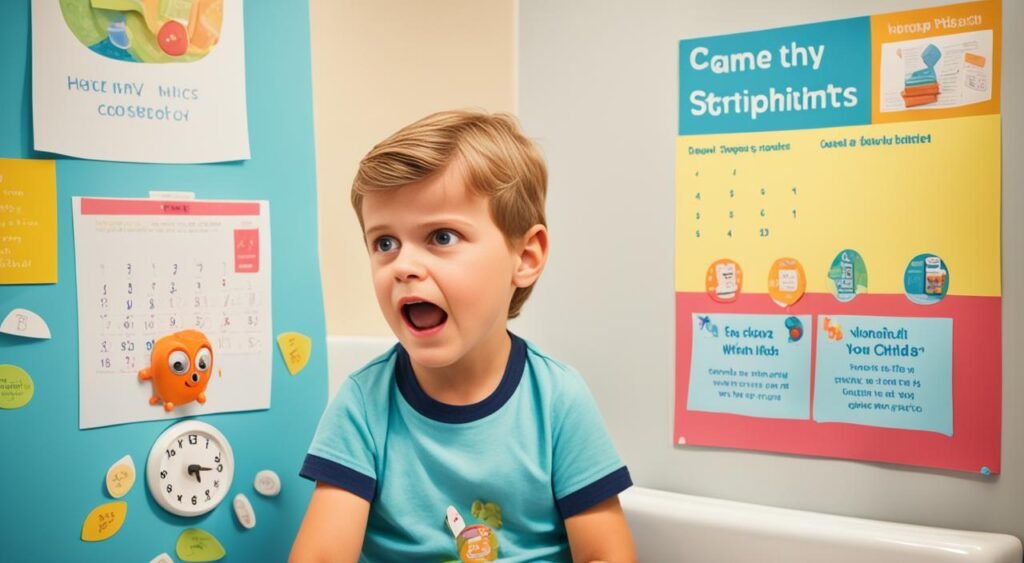Stool withholding, also known as poop holding, can be a challenging issue for parents to navigate. It often affects children who are potty training or have additional needs. Stool withholding can be triggered by constipation, illness, changes in routine, or fear of pain during bowel movements. If left unaddressed, this condition can lead to constipation and other complications.
To help parents understand and tackle stool withholding in children, this article provides insights into potential triggers, signs to watch out for, and the impact of this behavior. Additionally, practical strategies and tips will be shared to support children in overcoming stool withholding and promote healthy bowel habits.
Key Takeaways:
- Stool withholding is common in children who are potty training or have additional needs.
- Triggers for stool withholding can include constipation, illness, changes in routine, and fear of pain.
- Signs of stool withholding include straining, refusing to sit on the toilet, and making unusual facial expressions.
- Stool withholding can lead to constipation and various complications if not addressed.
- Strategies to stop stool withholding involve treating constipation and creating a relaxed environment in the bathroom.
Understanding Stool Withholding in Children
Stool withholding is a concerning behavior where a child purposefully avoids passing a bowel movement. This often occurs after a period of constipation or a painful bowel movement experience. Identifying the triggers for poop withholding is crucial in addressing and resolving the issue effectively.
Signs of Stool Withholding
- Straining on the toilet
- Refusing to sit on the toilet
- Making unusual facial expressions
- Holding their body in strange positions
- Denying the need to poop even when there are visible signs
It is important to pay attention to these signs as they indicate that your child may be holding in poop.
Triggers for Poop Withholding
Several factors can trigger stool withholding in children. Some common triggers include:
- Illness
- Passing a large stool
- Starting potty training
- A change in routine
- Discomfort using a different toilet
Understanding these triggers can help in identifying the root cause of the stool withholding behavior.
By comprehending why your child is holding poop, you can develop appropriate strategies to address the issue and help your child overcome stool withholding.
The Impact of Stool Withholding on Children
When children hold in poop, they can get trapped in a cycle of stool withholding that becomes increasingly difficult to break. Holding in poop can lead to chronic constipation and cause physical and emotional distress for the child. It can also result in stomach pain, urinary tract infections, bowel leakage, and bedwetting.
The consequences
- Chronic constipation: Holding in poop can lead to chronic constipation, as the stool becomes harder and more difficult to pass. This can further exacerbate the child’s discomfort and increase the likelihood of future stool withholding.
- Physical distress: Stool withholding can cause stomach pain and discomfort for the child. The accumulated stool creates pressure in the intestines, leading to bloating and cramping.
- Emotional distress: The fear and anxiety associated with bowel movements can have a significant emotional impact on the child. They may feel embarrassed, ashamed, or anxious about accidents or potential pain.
- Stomach pain: The build-up of stool can cause stomach pain and discomfort, making the child less inclined to eat and exacerbating the cycle of constipation.
- Urinary tract infections: Holding in poop can put additional pressure on the urinary tract and increase the risk of urinary tract infections.
- Bowel leakage: Stool withholding can lead to episodes of bowel leakage, where small amounts of stool leak out unintentionally.
- Bedwetting: The constant pressure on the bladder from stool withholding can contribute to bedwetting issues in children.
The longer a child holds in poop, the more challenging it becomes for them to start pooping regularly again. Therefore, it is important to address stool withholding early to prevent further complications and promote healthy bowel habits in children.
In order to fully understand the impact of stool withholding on children, it is crucial to consider both the physical and emotional consequences. Addressing constipation, providing a supportive environment, and seeking appropriate medical guidance can help alleviate the complications associated with stool withholding.
Strategies to Stop Stool Withholding
Stopping stool withholding in children requires a comprehensive approach that addresses both the physical and emotional aspects of the issue. By implementing the following strategies, parents can break the cycle of stool withholding and help their child develop healthy bowel habits.
Treating Constipation
The first step in stopping stool withholding is to address constipation. Softening the child’s stool and making it easier to pass can help alleviate discomfort and reduce the urge to withhold. Consider the following measures:
- Ensure the child consumes a balanced diet with ample fiber-rich foods such as fruits, vegetables, and whole grains.
- Encourage regular fluid intake to prevent dehydration and promote bowel movements.
- Consult with a healthcare professional about the appropriate use of stool softeners or fiber supplements to help regulate bowel movements.
Achieving regular, soft stools is crucial in preventing constipation and reducing the urge to withhold.
Creating a Comfortable Environment
The bathroom environment plays a significant role in a child’s comfort and willingness to poop. Creating a relaxed atmosphere can help alleviate anxiety and promote regular bowel movements. Consider the following tips:
- Provide a comfortable and child-friendly toilet seat or potty chair.
- Ensure the bathroom is well-lit and temperature-regulated.
- Offer distractions such as books, toys, or calming music to help the child relax during bathroom visits.
- Establish a consistent bathroom routine to help the child feel more secure and confident while pooping.
By creating a comfortable and supportive environment, parents can help their child overcome fear and anxiety associated with stool withholding.
Reinforcing Positive Behavior
Positive reinforcement plays a crucial role in breaking the stool withholding cycle. By acknowledging and rewarding the child’s efforts and progress, parents can encourage regular bowel movements. Consider the following approaches:
- Praise the child for sitting on the toilet or potty regularly, even if they don’t produce a bowel movement.
- Offer small rewards, such as stickers or a special treat, for successful pooping sessions.
- Promote a sense of accomplishment by maintaining a sticker chart to track the child’s progress.
Reinforcing positive behavior helps to replace fear and anxiety with confidence and motivation in the child.
By treating constipation, creating a comfortable environment, and reinforcing positive behavior, parents can effectively break the stool withholding cycle. Patience, consistency, and a supportive approach are key in helping children overcome this common issue and develop healthy bowel habits.
| Strategies to Stop Stool Withholding | Benefits |
|---|---|
| Treating Constipation | Relieves discomfort and reduces the urge to withhold |
| Creating a Comfortable Environment | Alleviates anxiety and promotes regular bowel movements |
| Reinforcing Positive Behavior | Encourages confidence and motivation in the child |
Supporting Children in Overcoming Stool Withholding

When it comes to stool withholding, providing reassurance and building your child’s confidence is crucial. By taking the time to explain to your child that their bowel movements will not hurt them anymore, you can help alleviate their fears and anxieties. This reassurance can go a long way in encouraging them to overcome stool withholding.
Staying calm and patient is important during this process. Understand your child’s point of view and avoid blaming or shaming them. By creating a supportive and understanding environment, you can help your child feel safe and comfortable in addressing their stool withholding issues.
Additionally, seeking resources such as books, videos, and factsheets can provide further guidance for both you and your child. These resources can offer valuable tips and techniques to navigate through the challenges of stool withholding and aid in your child’s progress.
Key Tips for Parents:
- Take the time to explain to your child that their bowel movements will not hurt them.
- Provide support and encouragement to alleviate their fear and anxiety.
- Stay calm and patient, avoiding blame or shame.
- Understand your child’s point of view and create a supportive environment.
- Seek additional resources such as books, videos, and factsheets for guidance.
Parents play a vital role in supporting their children through stool withholding. By providing reassurance, building confidence, and offering a supportive environment, you can help your child overcome this common issue and develop healthy bowel habits.
Conclusion
Stool withholding can be a challenging issue for both children and parents, but with the right approach, it can be overcome. By understanding the reasons behind stool withholding and addressing the physical and emotional aspects, parents can help their child develop healthy bowel habits.
Treating constipation is an essential step in breaking the stool withholding cycle. By ensuring the child’s stool is soft and easy to pass, parents can alleviate the discomfort associated with bowel movements. This may involve making dietary changes, increasing fluid intake, and using appropriate stool softeners or fiber supplements.
Creating a supportive environment is equally important. By providing reassurance, understanding, and patience, parents can help their child feel safe and relaxed during the bathroom routine. Building confidence and avoiding blame or shame are crucial in promoting positive behaviors and reducing fear and anxiety.
Remember, overcoming poop withholding takes time and patience. However, with the right strategies and support, children can develop regular, healthy bowel habits. By promoting healthy bowel habits in children, we can help them lead happier, more comfortable lives.
FAQ
How can I help my child stop holding in poop?
To help your child stop holding in poop, it is important to address both the physical and behavioral aspects of the issue. Start by treating constipation through diet changes, increased fluid intake, and the use of stool softeners or fiber supplements. Create a relaxed and comfortable environment in the bathroom to help your child feel safe while pooping. Reinforce positive behavior, stay calm, and avoid anger or frustration to break the stool withholding cycle.
Why is my child holding in poop?
There can be various reasons why a child holds in poop. Common triggers include constipation, illness, changes in routine, fear of pain during bowel movements, or discomfort using a different toilet. Identifying the underlying cause can help address the issue effectively.
What are the consequences of stool withholding in children?
Stool withholding can lead to chronic constipation, which causes physical and emotional distress for the child. It can also result in stomach pain, urinary tract infections, bowel leakage, and bedwetting. The longer a child holds in poop, the more challenging it becomes for them to start pooping regularly again.
How can I break the stool withholding cycle?
Breaking the stool withholding cycle involves treating constipation and addressing the fear and anxiety associated with pooping. Ensure your child’s stool is soft and easy to pass through diet changes, increased fluid intake, and the use of stool softeners or fiber supplements. Create a supportive environment, provide reassurance, and help build your child’s confidence in overcoming stool withholding. Stay calm, patient, and avoid blaming or shaming.
How can I support my child in overcoming stool withholding?
Supporting your child in overcoming stool withholding involves providing reassurance and confidence building. Take the time to explain to your child that bowel movements will not hurt them anymore. Create a supportive environment, stay calm and patient, and avoid blaming or shaming. Additional resources such as books, videos, and factsheets can also help you and your child navigate through the challenges of stool withholding.
How can I promote healthy bowel habits in my child?
To promote healthy bowel habits in your child, encourage a balanced diet rich in fiber and ensure they are drinking enough fluids. Establish a regular toileting routine and create a comfortable environment in the bathroom. Avoid pressuring or rushing your child during bowel movements and reinforce positive behavior. Seek professional advice if the issue persists.





